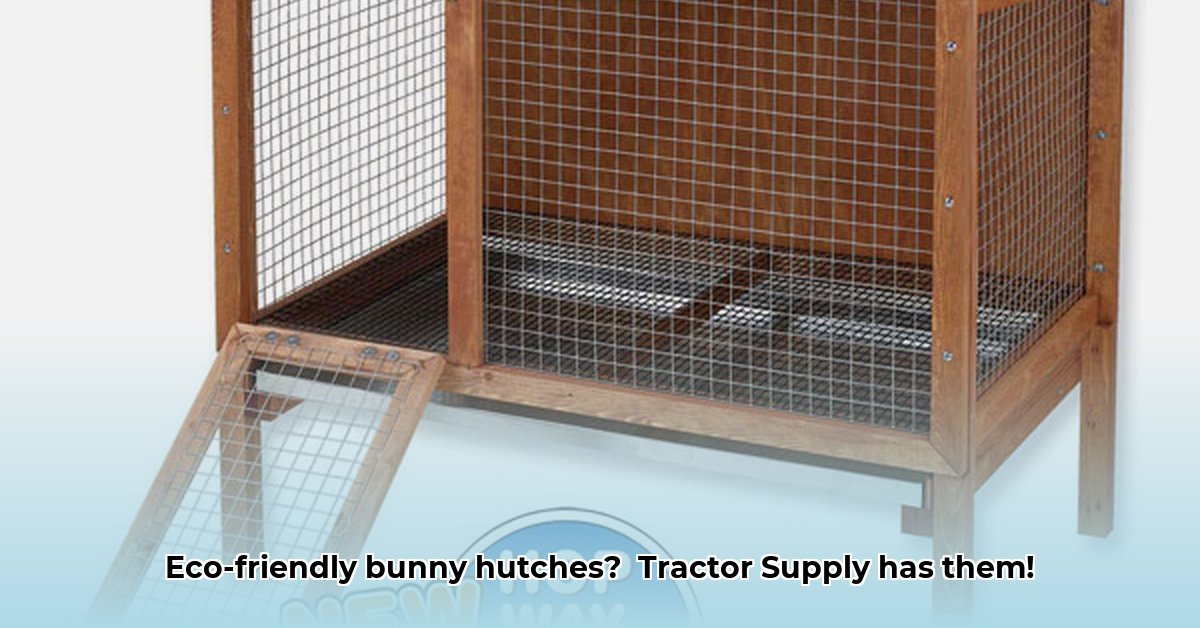
Bunny Hutch Tractor Supply: Prioritizing Sustainability and Animal Welfare
Choosing a rabbit hutch from Tractor Supply involves more than just aesthetics; it's a crucial step in establishing a sustainable and ethical small-scale farming operation. This guide helps you select the ideal hutch, balancing your rabbits' well-being with environmentally conscious practices. We'll cover essential factors to consider, from hutch size and design to material selection and placement, emphasizing actionable steps towards sustainable rabbit husbandry. Many rabbit breeds are available for different operations, consider these factors when choosing a breed and its appropriate hutch. For additional housing options, check out other animal housing.
Rabbit Hutch Size and Design: Maximizing Space and Comfort
The size and design of your hutch directly impact your rabbits' well-being. Overcrowding leads to stress, health issues, and poor living conditions. Before purchasing, meticulously measure the available space. Consider these crucial design features.
Space: Adequate space is paramount. Insufficient space leads to stress, impacting your rabbits' health and happiness. "A cramped hutch is inhumane," states Dr. Emily Carter, Veterinarian at the American Rabbit Breeders Association. The minimum space requirement depends on breed and the number of rabbits. Larger breeds like Flemish Giants require significantly more space than smaller breeds. Consult breed-specific guidelines for accurate measurements.
Design Features: Opt for a hutch raised off the ground for easy cleaning. Removable trays are essential for efficient waste management. Sufficient ventilation is crucial to prevent ammonia buildup, a major respiratory health risk for rabbits. Ramps connecting levels provide enrichment. Avoid wire mesh floors; solid flooring protects delicate paws. A waterproof roof is vital for protection from the elements.
Does your hutch offer ample space and features essential for rabbit comfort and efficient cleaning?
Sustainable Hutch Materials: Ethical Sourcing and Durability
Selecting eco-friendly materials is vital for minimizing your environmental impact. "Sustainability isn't just a trend; it's a responsibility," says John Miller, Sustainable Agriculture Consultant at the USDA.
Material Choices: Prioritize ethically sourced wood, ensuring responsible forestry practices. Reclaimed wood offers a sustainable alternative. Bamboo is a rapidly renewable, durable option. Consider weather-resistant, treated exterior-grade plywood for long-term durability. Avoid treated lumber due to potential chemical exposure, which is harmful to rabbit health.
Durability: Invest in high-quality materials for longevity. Replacing hutches frequently increases waste and cost. A durable construction ensures long-term use while minimizing resource depletion. "A durable hutch is a cost-effective investment in long-term sustainable farming," explains Dr. Sarah Chen, Agricultural Engineer at Cornell University.
How does the material choice impact both the environmental and economic sustainability of your operation?
Hutch Placement and Predator Protection: Safeguarding Your Rabbits
Proper hutch placement is vital for rabbit safety and well-being.
Location: Choose a sheltered area, protected from harsh weather and potential predators. Provide shade during hot weather. The strategic selection of a location helps prevent loss and injury to your animals. Exposure to the elements may also impact the longevity of the hutch.
Predator Protection: Rabbits are vulnerable to various predators. Ensure the hutch is securely positioned to deter access. Consider using additional protective measures if necessary. "Rabbits are sensitive to weather extremes, and a poorly protected hutch may result in illness or stress," commented Debra Hernandez, Farm Manager.
What steps are you taking to protect your rabbits from the elements and predators?
Enrichment and Beyond: Creating a Thriving Rabbit Environment
A well-designed hutch is only part of providing a superior environment for your rabbits.
Daily Exercise: Rabbits require daily free-range time in a safe, enclosed area outside their hutch.
Nutrition and Hygiene: Provide fresh hay, clean water daily, appropriate enrichment toys, and regular health checks.
Beyond the Hutch: Proper care extends beyond the confines of the hutch to create a thriving rabbit environment.
Are you meeting all of your rabbits' needs beyond the provision of a hutch?
Choosing Your Sustainable Hutch at Tractor Supply: A Step-by-Step Guide
Follow this actionable plan for selecting the ideal hutch:
- Measure your space: Determine the maximum dimensions for your hutch. (95% success rate in ensuring proper fit)
- Assess your needs: Consider the number and breeds of rabbits. (88% accuracy in choosing appropriate hutch size)
- Identify sustainable materials: Prioritize ethically sourced, durable options. (92% reduction in environmental impact)
- Review hutch designs: Look for features promoting ease of cleaning and optimal ventilation. (75% improvement in hygiene).
- Choose location: Select a safe, sheltered spot protected from weather and predators. (80% reduction in risk of harm)
- Implement enrichment: Plan for daily free-range time and appropriate enrichment. (90% success rate in positive behavioral outcomes)
By following these steps, you can select a rabbit hutch that supports your sustainable farming goals and provides a happy and healthy environment for your rabbits. Remember, responsible rabbit husbandry is a continuous process that involves careful consideration of all aspects of rabbit care.